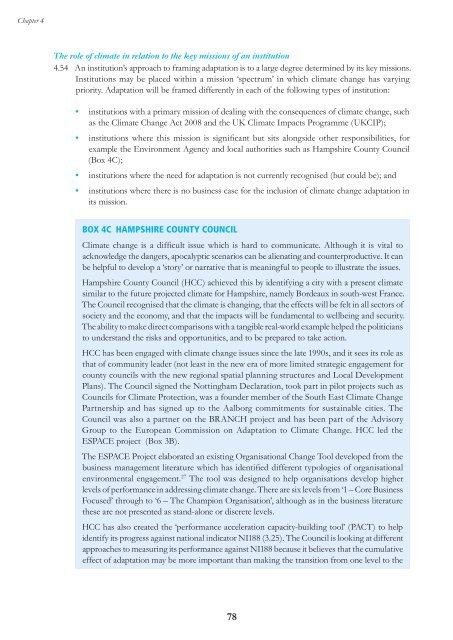Twenty-eighth Report Adapting Institutions to Climate Change Cm ...
Twenty-eighth Report Adapting Institutions to Climate Change Cm ...
Twenty-eighth Report Adapting Institutions to Climate Change Cm ...
You also want an ePaper? Increase the reach of your titles
YUMPU automatically turns print PDFs into web optimized ePapers that Google loves.
Chapter 4<br />
The role of climate in relation <strong>to</strong> the key missions of an institution<br />
4.54 An institution’s approach <strong>to</strong> framing adaptation is <strong>to</strong> a large degree determined by its key missions.<br />
<strong>Institutions</strong> may be placed within a mission ‘spectrum’ in which climate change has varying<br />
priority. Adaptation will be framed differently in each of the following types of institution:<br />
<br />
<br />
<br />
<br />
institutions with a primary mission of dealing with the consequences of climate change, such<br />
as the <strong>Climate</strong> <strong>Change</strong> Act 2008 and the UK <strong>Climate</strong> Impacts Programme (UKCIP);<br />
institutions where this mission is significant but sits alongside other responsibilities, for<br />
example the Environment Agency and local authorities such as Hampshire County Council<br />
(Box 4C);<br />
institutions where the need for adaptation is not currently recognised (but could be); and<br />
institutions where there is no business case for the inclusion of climate change adaptation in<br />
its mission.<br />
BOX 4C HAMPSHIRE COUNTY COUNCIL<br />
<strong>Climate</strong> change is a difficult issue which is hard <strong>to</strong> communicate. Although it is vital <strong>to</strong><br />
acknowledge the dangers, apocalyptic scenarios can be alienating and counterproductive. It can<br />
be helpful <strong>to</strong> develop a ‘s<strong>to</strong>ry’ or narrative that is meaningful <strong>to</strong> people <strong>to</strong> illustrate the issues.<br />
Hampshire County Council (HCC) achieved this by identifying a city with a present climate<br />
similar <strong>to</strong> the future projected climate for Hampshire, namely Bordeaux in south-west France.<br />
The Council recognised that the climate is changing, that the effects will be felt in all sec<strong>to</strong>rs of<br />
society and the economy, and that the impacts will be fundamental <strong>to</strong> wellbeing and security.<br />
The ability <strong>to</strong> make direct comparisons with a tangible real-world example helped the politicians<br />
<strong>to</strong> understand the risks and opportunities, and <strong>to</strong> be prepared <strong>to</strong> take action.<br />
HCC has been engaged with climate change issues since the late 1990s, and it sees its role as<br />
that of community leader (not least in the new era of more limited strategic engagement for<br />
county councils with the new regional spatial planning structures and Local Development<br />
Plans). The Council signed the Nottingham Declaration, <strong>to</strong>ok part in pilot projects such as<br />
Councils for <strong>Climate</strong> Protection, was a founder member of the South East <strong>Climate</strong> <strong>Change</strong><br />
Partnership and has signed up <strong>to</strong> the Aalborg commitments for sustainable cities. The<br />
Council was also a partner on the BRANCH project and has been part of the Advisory<br />
Group <strong>to</strong> the European Commission on Adaptation <strong>to</strong> <strong>Climate</strong> <strong>Change</strong>. HCC led the<br />
ESPACE project (Box 3B).<br />
The ESPACE Project elaborated an existing Organisational <strong>Change</strong> Tool developed from the<br />
business management literature which has identified different typologies of organisational<br />
environmental engagement. 27 The <strong>to</strong>ol was designed <strong>to</strong> help organisations develop higher<br />
levels of performance in addressing climate change. There are six levels from ‘1 – Core Business<br />
Focused’ through <strong>to</strong> ‘6 – The Champion Organisation’, although as in the business literature<br />
these are not presented as stand-alone or discrete levels.<br />
HCC has also created the ‘performance acceleration capacity-building <strong>to</strong>ol’ (PACT) <strong>to</strong> help<br />
identify its progress against national indica<strong>to</strong>r NI188 (3.25). The Council is looking at different<br />
approaches <strong>to</strong> measuring its performance against NI188 because it believes that the cumulative<br />
effect of adaptation may be more important than making the transition from one level <strong>to</strong> the<br />
78
















